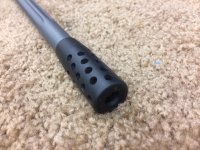And BTW the main article ref'd above in Tooley's post contains one salient mis-perception if I'm reading it correctly. He rambles on about "not being able to easily measure the effect of the gases" and "diversion of said gases so they don't contribute to the recoil equation" which shows that he doesn't understand how brakes work. As his article shows, brakes DO WORK but how they work is interesting. And in his case, misunderstood. (His testing apparatus is also flawed, but I digress) He furthermore makes this statement "Since the force felt by the shooter is a combination of those two forces, to get the full story on recoil, it must be measured instead of calculated." Again showing his misunderstanding. In most cases, when the "theoretical" mismatches the "measured" it's the fault of the "theory"..... His theory is flawed. And it shouldn't be, needn't be IMO.......This ain't Dark Matter here

we aren't trying to rectify the mass of the known universe, just our little corner of it. He entirely misses the mark. Once gasses have been accelerated and leave the muzzle THEIR WORK IS DONE in the recoil equation. What the brake does is add a 3rd component to the action/reaction equation, a component NOT ACCOUNTED FOR in the blog from Mr Zant. All the math in the world doesn't change the fact that what a brake actually does is AFTER ALL RECOIL HAS HAPPENED, it catches a bunch of the gas that's already been expended and uses it to "catch" the rifle. That gas was GONE..... it's work was DONE...... the recoil equation was BALANCED........ and then the brake catches this moving gas (wind) like a sailboat sail catches moving gas (wind) and REUSES IT, in other words, you add a catching device (sail) onto the rifle and use it to pull the rifle off the shooter. It's as if you tied a rope from the rifle to the bullet..... and when the bullet hits the end of the rope, it pulls the rifle forward. In simple fact, the impact plates in the brake catch the expended "wind" and yank the rifle off the shooter. This is measurable, predictable, and simply WHY Harrell's brakes are as effective as they are (SO EFFECTIVE that test after test IGNORES them!!) LOL al



